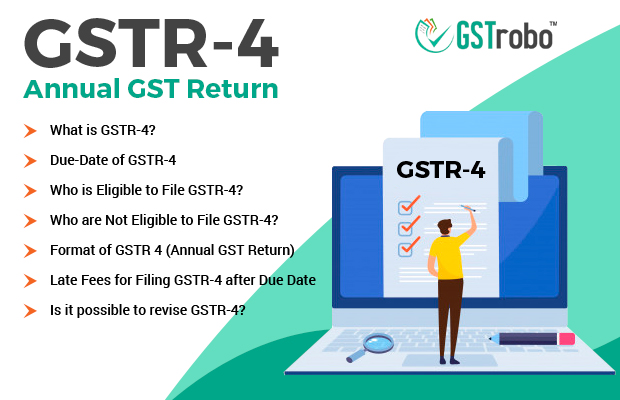GSTR-4: Annual GST Return
From the financial year 2019-20, the composition scheme holder needs to file CMP-08 every quarter and GSTR-4 annually. In this article, we will know everything about GSTR-4 an annual GST return.

What is GSTR-4?
GSTR-4 is an annual GST return that needs to be furnished by a composition dealer annually until the financial year 2018-19, the return was filed every quarter which got replaced by CMP-08. GSTR-4 contains the summary of outward supplies, Inward supplies, import of services, and supplies attracting reverse charge.
Due-Date of GSTR-4
The composition scheme holder needs to file GSTR-4 annually every 30th of April.
For example, the GSTR-4 for the financial year 2021-22 is due by 28th Feb 2022.
Who is Eligible to File GSTR-4?
Here is the list of the person who is eligible to file GSTR-4
- Composition Scheme Holder.
- Special composition scheme notified for the service providers.
- Composition scheme holders who have subsequently opted out from the scheme any time during the year.
- Composition scheme holders who have opted in for composition scheme before starting of the financial year.
Who are Not Eligible to File GSTR-4?
Here is the list of taxpayers that are not eligible to file GSTR-4:
- Non-resident Taxable Persons
- Taxpayers required to collect TCS
- Taxpayers required to deduct TDS
- Input Service Distributors (ISD)
- Casual Taxable Person
- Taxpayer providing Online Information Database Access and Retrieval services
- UIN Holders and Regular taxpayer who have not opted in composition scheme
Format of GSTR 4 (Annual GST Return)
There are nine sections in the revised Annual GSTR-4 Form explaining each section below:
Table 1. GSTIN (Auto-Populated)
Table 2. Name – Legal name and trade name (if any) will get auto-populated
Table 3. Aggregate Turnover Details – This table will get auto-populated
Table 4. This table will capture the details of inward supplies and supplies attracting reverse charge and import of services. Table 4 has four different sections – 4A, 4B, 4C, 4D.
Table 5. This table will contain self-assessed liability as per the GST CMP-08 Form. The following details get auto-populated from the GST CMP-08 Form.
- Net of advances
- Credit and Debit Notes and
- Any other adjustment due to amendments etc.
Table 6. This table will capture the tax wise details of inward supplies and outward supplies that attract reverse charge along with the total taxable value. However, it shall be noted that the IGST, CGST, SGST, and CESS values will get auto-populated.
Table 7. In this table the taxpayer filing GSTR-4 needs to enter the GSTIN of the deductor, gross invoice value, and the total amount of TDS deducted.
Table 8. This table contains the following details:
- Type of tax
- Tax amount that has to be paid: Auto-filled from the above Table 6.
- Amount of tax already paid: Auto-filled from CMP-08.
- Balance Tax amount to be paid: The difference of (ii) and (iii).
- Interest payable and paid: Needs to be mentioned by the taxpayer.
- Late fee payable and paid: Needs to be mentioned by the taxpayer.
Table 9. Using this table the taxpayers can claim a refund in case of excess tax paid.
It shall be noted that the taxpayer needs to authenticate the GSTR-4 form by digitally signing it or can be filed via EVC as well.
Late Fees for Filing GSTR-4 after Due Date
In case if the taxpayer does not file the GSTR-4 on time he/she needs to pay INR 200 per day as a late fee.
However, it shall be noted that not more than INR 5,000 can be charged as late fees.
Is it possible to revise GSTR-4?
GSTR 4 once filed on the GST portal cannot be revised.
About GSTrobo®
GSTrobo®, a division of Binary Semantics, one of the leading ASP- GSP realized the changing landscape of compliance and introduced GST compliance solutions such as GST, e-way bill, and e-invoicing software and applications. These solutions seamlessly integrate with all the leading ERPs such as SAP, Oracle, Microsoft Navision, etc. In addition, these software and applications automate most of your GST compliance needs that saves you time and also eliminates the scope of error.
